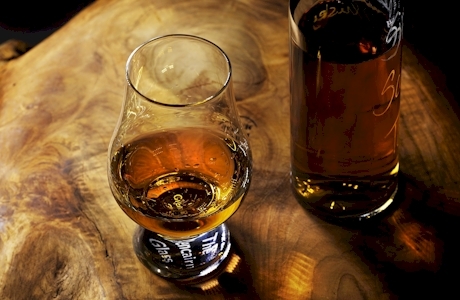CLASSIFYING SCOTCH BY FLAVOR-AROMA CLUSTERS
In the late 1980s and early 1990s, British journalist and reviewer Michael Jackson became the world’s leading authority on Scotch, and in 1994, he wrote a compendium of Scotch information entitled “Michael Jackson’s Complete Guide to Single Malt Scotch.” His book became the bible of Scotch whisky, detailing and rating over 1000 Scotch whiskies based on a quality rating scale of 0-100. He often touted that any Scotch rated 75 or above would be worthy of purchase, and receiving a high rating either in his book, or in one of his review articles became the holy grail for Scotch producers.
In the late 1990s, a British statistician and classification expert, Dr. David Wishart, began developing a more objective Scotch classification system. While Mr. Jackson’s ratings weres based on his own subjective comparisons and ratings, Dr. Wishart’s system created quantifiable attributes meant to accurately describe the flavors and aromas of Scotch, and using them classify Scotch based on those characteristics.
In 2002, Dr. Wishart published his book “Whiskey Classified: Choosing Single Malts By Flavour.” Wishart argued that while Jackson’s rating system gave Scotch enthusiasts a quality rating on which to make purchase decisions, it was essentially “one man’s opinion.” Dr. Wishart’s revolutionary classification system resulted in a far more objective way to compare whiskies, and ultimately, to choose based on taste preferences. These two methods are hotly debated today, but in my humble opinion, Dr. Wishart’s method is more useful, and is the basis by which I choose Scotches that I buy!
He identified 12 major flavor categories: Body, Sweetness, Smoky, Medicinal, Tobacco, Honey, Spicy, Winey, Nutty, Malty, Fruity, Floral
Every Scotch that he included (he attempted to select representative whiskeys from a wide swath of producer) was rated for each of these attributes on a scale from zero (not present) to four (pronounced). His book shows the complete rating for each whiskey reviewed. Of course, one of the shortcomings of this methodology is that different producers may make a range of expressions that can possess dramatically different characteristics. As a result, it is recommended that this system be used as a starting point for forays into Scotch appreciation. As always, it can be combined with other resources where needed to determine any specific whisky’s flavor pattern.
Caveats aside, the resulting classifications provide 10 distinct Scotch whisky styles, labeled Clusters A through J, ranging from strongly sherried and sweet, to dry and heavily peated. This system makes it much simpler for Scotch whisky drinkers to select a Scotch that more accurately represents their flavor preferences.
Cluster A:
Full-bodied, medium-sweet, pronounced sherry with fruity, spicy, and malty notes plus nutty, smoky hints.
Examples: Balmenach, Dalmore, Glendronach, Macallan, Royal Lochnagar.
Cluster B:
Medium-bodied, medium-sweet, with nutty, malty, floral, honey, and fruity notes.
Examples: Aberlour, Ben Nevis, Blair Athol, Cragganmore, Glenfarclas, Knockando, Scapa.
Cluster C:
Medium-bodied, medium-sweet, with fruity, floral, honey, and malty notes with spicy hints.
Examples: Balvenie, Glenlivet.
Cluster D:
Light, medium-sweet, low or no peat, with fruity, floral, and malty notes with nutty hints.
Examples: An Cnoc, Auchentoshan, Tobermory.
Cluster E:
Light, medium-sweet, low peat, with floral, and malty notes with fruity, spicy, honey hints.
Examples: Bunnahabhain, Glenkinchie, Inchgower, Inchmurrin, Tomintoul.
Cluster F:
Medium-bodied, medium-sweet, low peat, and malty notes with sherry, honey, and spicy hints.
Examples: Ardmore, Glenrothes, Old Fettercairn. Tomatin, Tullibardine.
Cluster G:
Medium-bodied, sweet, low peat and floral notes.
Examples: Arran, Glenfiddich, Glen Spey, Miltonduff, Speyburn.
Cluster H:
Medium-bodied, medium-sweet, with smoky, fruity, spicy notes and floral, nutty hints.
Examples: Balblair, Glenmorangie, Oban, Old Pulteney, Tamnavulin.
Cluster I:
Medium-light, dry, with smoky, spicy, honey notes and nutty, floral hints.
Examples: Bowmore, Highland Park, Isle of Jura, Springbank.
Cluster J:
Full-bodied, dry, pungent, peaty and medicinal, with spicy, feinty notes.
Examples: Ardbeg, Lagavulin, Laphroaig, Talisker.
Dr. Wishart created a highly useful classification system that is particularly well suited for learning about Scotch whisky. As your tasting experience expands, and your palate refines, you can use this system as a springboard into wider experimentation. Once you have a solid understanding of Scotch whisky, you can use the additional resources available online to help your appreciation expand. As always, the ultimate classification system is your own mouth- only you can know what you like and don’t like. Don’t be afraid to experiment!
ACKNOWLEDGEMENT:
The source of some of the above information is acknowledged as follows:
Whisky Classified: Choosing Single Malts by Flavour
David Wishart, Pavilion Books, London 2002.

